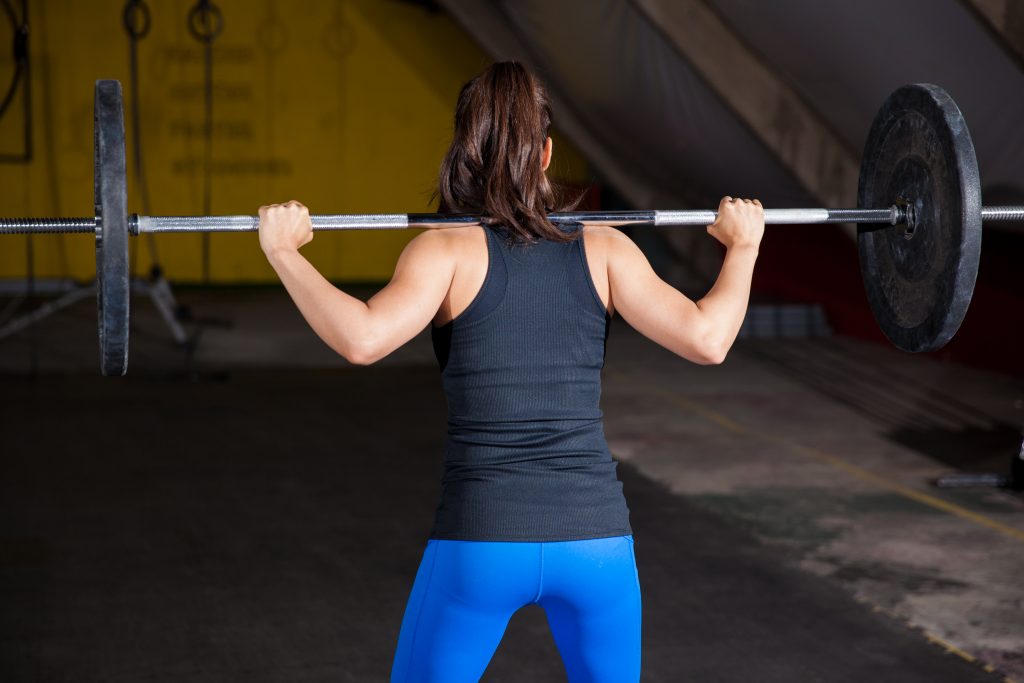How to Address a Hip Shift During Your Squat
Do you exhibit a hip/weight shift (swaying to the left or right) when you perform a squat? It’s one of the more annoying things that can happen in the weight-room.
It ranks somewhere in between people who don’t re-rack their weights and kipping pull-ups.
Admittedly, it’s rather common and almost always a benign occurrence; most people never even notice it unless they’re routinely filming their squat sessions.
And when that is the case, I can understand someone’s “itch” to want to solve the conundrum. I mean, things could go awry down the road and manifest into pesky hip or knees issues.

Copyright: antoniodiaz
A Case Study: How to Address a Hip Shift During the Squat
I received the following email earlier this week:
“I was looking to see if I might be able to send you some videos for a squat assessment. I have been having issues leaning to my right for some time and cannot for the life of me figure out what is causing the issue. I’ve followed you for years and trust your judgement!”
How could I say no?1
I responded back with a “sure, I can take a quick look,” and in swift fashion I got this in return:
“Some initial feedback would be great.
Some things to note before watching:
- Though subtle, I find my left hip lower than my right on both the descent and ascent of the squat (as you can probably see).
- My right hip flexor/quad tends to be tighter than my left usually.
- My left glute has always been tighter than my right
- History of SI joint hypermobility (in the past) but has not caused me issues for over a year. I used to have issues with my sacrum shifting around and causing misaligned hips which was quite painful.
- I do not have any pain barbell squatting or semi sumo deadlifting but I do feel the unevenness when I squat especially.”
For Starters
That’s a pretty good lookin squat if you ask me.
After reading her “heads up” commentary before watching the video I was half expecting a dumpster fire when I pressed play.
Au contraire – all things considered, that’s a very passable squat.
However, given her past injury history, her own words of feeling the “unevenness,” not to mention you can see a subtle weight shift to the right with each repetition, I had some thoughts.
It’s funny, I perused my blog archives to see whether or not I had written on this topic in the past, and as it happens I did!
Back in 2015 I wrote THIS post where I discussed the idea “feeding the dysfunction,” a concept taken straight from renowned physical therapists (and creators of the Functional Movement Screen), Gray Cook and Lee Burton.

The gist goes like this:
You see a weight shift, say, to the right. In this scenario you grab a band and wrap it around the individual’s waist and as he or she squats, you pull the band in the direction of the shift, essentially “feeding the dysfunction.” The idea is that reactive neuromuscular training (RNT) trains the nervous system to recognize a faulty movement and to encourage body to correct course.
In the broader consciousness of health/fitness it’s an okay approach. It 100% works. In the years since writing that blog post, however, I’ve gone out of my way to reduce my use of the word “dysfunction” with clients. I don’t like the connotation the word breeds; that the individual is in some way broken or needs fixing.
Some people hear or see the word dysfunction and they’re ordering an exorcism.
Myself?
I hear or see dysfunction and I think “well, outside of extenuating circumstances (past/current injury history, whether or not there’s pain present), it’s fairly normal.”
Everyone is a bit different and moves in different ways. What’s more, there are, what, seven billion people on this planet currently? Is the expectation that everyone, everywhere, in the history of ever, is going to squat (or move) the same exact way?
(calls my inner Commodus)
Okay, Tony, We Get It, Personal Growth, Blah Blah, Blah…WTF Did You Tell Lisa To Do?
This, I said this:
“I totally see what you’re saying when you say your left side is lower than your right. I don’t think we need to get too far into the weeds as to whether or not that “needs” to be corrected (or even if it’s bad).
While slight, the hip shift IS there, and I think there are one of two things you can try”
1) Lean Into the Asymmetry
(NOTE: I actually wrote my thoughts on asymmetry HERE a few years ago).
I asked her to externally rotate (open up) her right foot more and to take note whether or not that improved her weight shift?
If so, there’s her answer.
People are built differently and what this would suggest is that her right hip socket is likely more retroverted compared to her left and that that side requires a bit more ER.
For many, using a “symmetrical” stance is akin to attempting to fit a square peg into a round hole. We don’t live in textbooks, so we shouldn’t train like it either.
She tried it and (no surprise to me) saw an improvement:
But Tony, Won’t Having Her Squat With An Asymmetrical Stance Lead to More Issues Later? What’s Next: Telling Her to Club a Baby Seal? No, Wait, To Go Keto?
Relax.
I truly don’t feel having someone perform a handful of sets with an asymmetrical stance is going to cause irreparable harm. I mean, I’d make the case that forcing symmetry is leading to more issues. Besides, if a certain stance feels better, feels more secure, stable, and powerful…why wouldn’t we want to lean into that?
Furthermore, the human body is a bit more resilient than that. If it can survive plagues, saber-toothed tigers, and Michael Bay Transformer movies, it can withstand a few sets of asymmetrical squats.
Further furthermore, this is why we use things such as single leg work to help fill in the gaps. There’s a reason why we write well-rounded training PROGRAMS. You know, to address stuff.
So anyway, moving her foot out a bit seemed to have solved the issue. This strategy will work for most people, but what happens when it doesn’t?
2) Listen to Katie St. Claire
This scenario reminded me of something my colleague, Katie St. Claire, discussed last year. She showed a video of one of her clients who also had a hip shift to the right on her squat.
Katie recommended the woman perform 15 hip bridges (off the wall) on her LEFT side only.
Now, why the LEFT side only in order to fix a RIGHT sided issue?
In Katie’s Words:
“To allow more posterior rotation and nutation on the left side so she can load the right side correctly.”
In non-Elvish, as you squat down into deeper hip flexion (most often in Stage 2: 60-120 degrees of hip flexion), the inability for the LEFT side to internally rotate and compress essentially “pushes” you to the right.
I don’t know, maybe that still sounds confusing.
Try this: Whatever side you shift to, perform a boat-load of bridges on the OPPOSITE side. Chances are you will see an improvement.
Cool?
Cool.
Give both options a try and see if one of them solves the issue.
I bet they will…;O)


